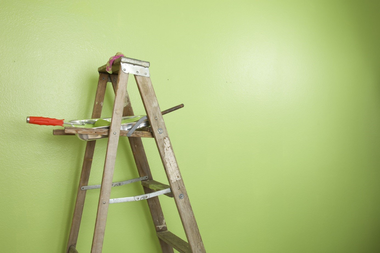Improving air quality via smart sustainable coatings
(29-05-2019) Ghent University and Dow Benelux collaborated on developing smart sustainable coatings that can trap harmful chemical emissions and help improve air quality
A special sustainable paint that filters harmful substances out of the air. This may seem like something for the future, but it has already been researched in the SUSCOAT project by Ghent University and Dow Terneuzen from the GREEN-CHEM network. In this public-private collaboration possibilities were investigated to make the polyurethane coatings of Dow produces more sustainable and ‘smarter’. A first product that can trap and prevent the release of toxic formaldehyde has already been released on the market, known as FORMASHIELD™.
The team of prof. Filip Du Prez at Ghent University joined forces with Dow Benelux in the SUSCOAT project to develop smart sustainable coatings that can trap harmful chemical emissions and help improve air quality.
“The specific goal of SUSCOAT was to use alternative approaches to formulate polyurethane coatings with different chemical functionalities that can scavenge harmful chemical emissions”, says prof. Filip Du Prez. “We implemented a new chemical platform, which allows us to combine polymerisation and addition of new chemical functionalities in a one-pot approach.”
Green and functional coatings
Multi-functional molecules are embedded into polymeric coatings and act as scavengers of volatile organic compounds (VOC’s). These VOC’s can be released into indoor air from building materials and have a negative effect on air quality and health.
An example of this is filtering a hazardous substance like formaldehyde out of the air. Formaldehyde is a substance released from, for example, furniture materials in which chipboard is processed. The chipboards are composed of compressed wood shavings and are glued with formaldehyde-containing resins. Formaldehyde is also naturally present in wood. “By processing these materials with a special coating, we can limit their negative effects”, explains the polymer expert.
This approach for synthesizing polyurethane coatings incorporates sustainable and green chemistry by using renewable substrates, eliminating phosgene and preventing direct exposure to isocyanates during coating application.
Public-Private Partnership
The SUSCOAT project is a Marie-Curie fellowship funded under the European 7th Framework Program. This program provides PhD students with opportunities to perform half of their research at the labs of an industrial partner and to participate in technology transfer.
Besides the support from the university, the students are also accompanied by employees from the R&D Department at Dow. Not a small investment for Dow, but they get a lot of knowledge and expertise in return. “This also means that the students gain a lot of practical experience”, continues prof. Du Prez. “They are reminded of the fact that the research should be applicable within the chemical industry and that it should finally answer to the customer’s request. This makes the research more challenging, but the potential immediate benefit for society definitely more interesting.”
Prof. Du Prez: “We have a long-standing expertise in developing functional polymers starting from tailor-made organic building blocks. Dow Benelux on the other hand has extensive capabilities in R&D and business development of polyurethanes. This resulted in a good mix of complementary skills in this collaboration.” Dow has already released a first product on the market, known as FORMASHIELD™.
Future efforts are focused on expanding the potential applications of sustainable coatings by developing water-based and high solids formulations that will further reduce the environmental impact.
